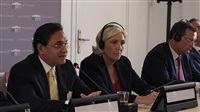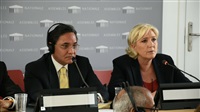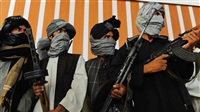Why do European youth join Daesh? radical movements in Europe (2)

Western Europe witnessed the emergence of more active far right movements than any other geographical area in the world did. During the Cold War, a number of such movements popped up in a number of Western European states to defend national interests and prevent change. Most of these movements appeared in reaction to the success of revolutionary leftist movements that demanded change. Far right movements enjoyed support from social classes that feared the loss of their economic, social and political gains. These classes were threatened by reforms initiated by Western European governments and also by socialist incitement against them. They were also threatened by the flow of immigrants to Western European countries.
Far right movements proved to be able
to commit extreme violence, even as they did not possess the organizational
capabilities the movements of the far left possessed throughout most of the
Cold War. This caused great suffering in a number of Western European
societies, such as Italy where far right movements claimed to have received
support from renegade Italian intelligence officials.
The fact is that far right movements
made their presence strongly felt throughout the 1970s and 1980s because they
received support from civilian and military intelligence agencies in Western
European states. The Italian intelligence worked to use extremism, blamed most
of the time on the far left, to incite the public against the left and also
make them call for action to protect law and order against this left (5).
Come the Cold War to an end, the far
right lost all justifications for its actions. The might that is communism had
shriveled up and died by then, opening the door for the emergence of another
might, namely immigration. One of the theoreticians of what was known as the
Frankfurt School wrote a book about what he called the "inciters", or
more accurately those far right members who incited against immigrants.
By the 1990s, the iron curtain that was
wrapped around Europe was removed. This caused immigrants to flock to Europe
and the Western world in general. The struggle for better payments and living
conditions was set into motion. However, immigration fuelled ethnic conflicts
in the Balkans and the former Soviet Union. They also caused wars, famine and
endemics to spread like wildfire in Africa (6).
The arrival of immigrants, refugees and
political asylum-seekers in Europe has had deep effects on social and economic
stability. Western Europeans viewed those foreigners arriving in their
countries as direct competitors for jobs, housing, and health services. They
also viewed those foreigners as a direct threat to the national identities of
their countries and their values. Some people even tried to portray immigrants
as criminals, law-breakers, and a menace to the social fabric in their
countries. These feelings were exploited by the far right in justifying its
crimes. The same feelings brought support to far right parties. This was
evident in the appearance of a subculture, backing to neo-Nazism (7).
Anti-immigrant movements appeared
throughout most of Western Europe in the 1990s. In Brussels, an anti-immigrant
movement appeared and lived several years. This organization stood behind a
number of bomb attacks against foreigners. The members of the organization
included racist gangsters. In France, there were three Neo-Nazi organizations,
namely the European Nationalists, Third Way and the Revolutionary Nationalist
Youth Group. Each of these organizations received support from the adherents of
the subcultures. These organizations were believed to have been the first to
incite attacks on the homes of refugees and immigrant workers in Lille, Brest,
Rouen, Marseille, and Paris.
In the UK, Combat 18 organization was
considered by police as the main representative of the far right. This
organization hammered out arms deals with paramilitary forces in Northern
Ireland. It also claimed responsibility for two bomb attacks in central London.
In the Netherlands, two racist
organizations, namely the Youth Front and the National Socialist Labor Front,
appeared. The latter organization functioned as a branch of the German National
Labor Front in the Netherlands. Three of the leaders of this organization were
arrested for possessing arms and Nazi materials (8).
On the other hand, leftist movements appeared
to target banks, the symbols of capitalism and the offices of international
organizations.
In Belgium, the Communist Combatant
Cells emerged at the end of the 1970s. This organization staged a number of
attacks, including ones on NATO positions and sites of nuclear arms. The
Communist Combatant Cells coordinated their actions with other leftist
movements, including the Red Army Faction in Germany and the Red Brigades in
Italy (9).
The Red Army Faction was founded in
1968 by Andreas Baader (1943 – 1977) and Ulrike Meinhof (1943 – 1976). Faction
members got financing for their operations at first from burglaries, including
of banks and companies. The movement bombed some of its targets and set others
on fire. Most of the operations of the Red Army Faction targeted West German
and American companies. It also participated in the kidnap and assassination of
politicians and outstanding businessmen in West German.
By the mid-1970s, the Red Army
Faction's operations assumed an international dimension. It hammered out
alliances with some Palestinian movements. Two faction members participated in
the hijacking of an Air France plane flying from Tel Aviv to Paris in 1976. The
plane hijacking precipitated an Israeli raid on Entebbe International Airport
in Uganda. The two German hijackers were killed in the raid (10).
The Red Brigades is an underground
extremist leftist organization that appeared in Italy in 1969. It wanted to
create a revolutionary buzz through an armed struggle based on Marxist-Leninist
principles. The movement also campaigned against Italy's NATO membership.
The organization was founded by Renato
Curcio who founded the first leftist group at the University of Trento in 1967.
This group was committed to the study of Carl Marx, Mao Zedong and Che Guevara.
After he got married to Margherita Cagol, Curcio moved to Milan where he
started assembling hardliners before he announced his organization in November
1970. Curcio promulgated the birth of his movement by throwing incendiary bombs
on factories and warehouses in Miland.
In its second year, the Red Brigades
turned to kidnappings. In 1974, the organization carried out its first murder
by killing the head of the Counterterrorism Department in Trento. The
organization then moved to the kidnapping and assassination of Italian cabinet
members and leading businessmen. The organization killed the late Italian prime
minister Aldo Moro in 1978. It also kidnapped the retired American army officer
James L. Dozier for 42 days in 1981 before he was rescued by Italian police
(11).
The members of the organization
included Italian thinker Antonio Negri who co-authored the famous book
"Empire". Negri was accused of being the mastermind of the Red
Brigades. He fled to France where he was given support by the French
government. Negri pursued studies at the University of Paris and worked side by
side with French philosophers Gilles Deleuze, Michel Foucault and Jacques
Derrida.
Negri returned to Italy when the jail
sentence issued him was remitted to 13 years from 30. He handed himself over to
the authorities to serve the sentence. He authored his most famous books behind
bars.
Extremist movements, both rightist and
leftist ones, depend on a dual way of thinking in relation to how they view
themselves and how they view their targets and victims. This way can be
detailed as follows:
First,
view of oneself
The backers of these movements view
themselves as an elitist group of enlightened people. Leftists, for example,
view themselves as the victims of persecution, not victimizers. They believe
that they have no choice but to maintain their struggle. They think they are
the force that enlightens the ignorant public. They view themselves as the
owners of pure ethics in corrupt surroundings.
Second,
view of the enemy
Extremist movements always look down
on, belittle and denigrate their enemies. They view these enemies as killer
ghosts who have no humanity whatsoever. To these movements, these enemies are
only a bunch of targets, not real humans who have families and children.
Third,
nature of struggle
Extremists always view themselves as
part of a struggle between good and evil. They believe they are fighting to
protect good against evil. This is why these extremists think they are obliged
to maintain this fight.
Fourth,
view of innocent victims









